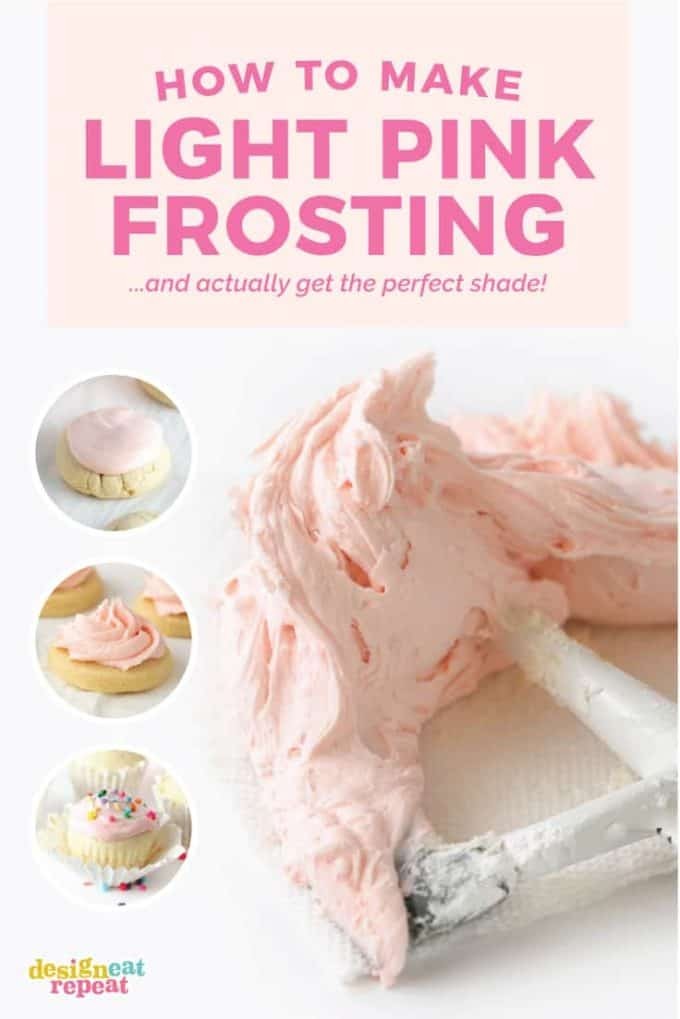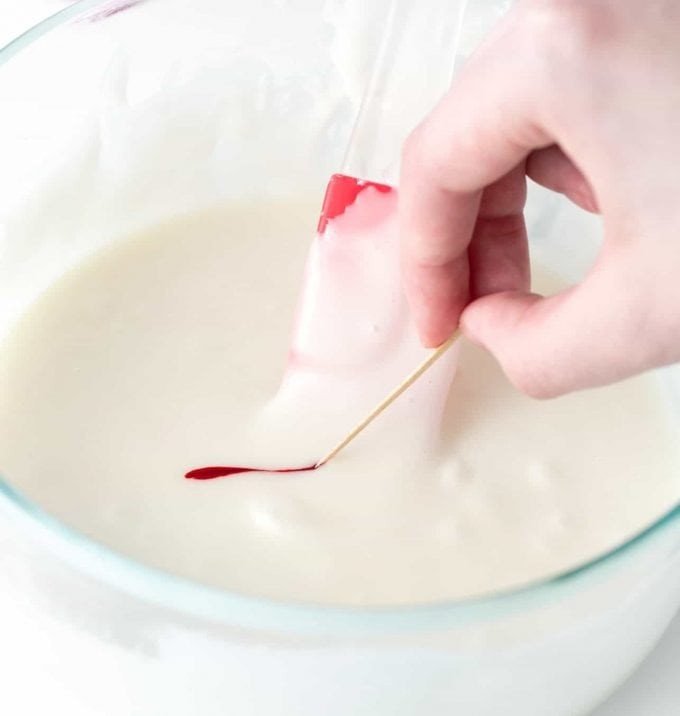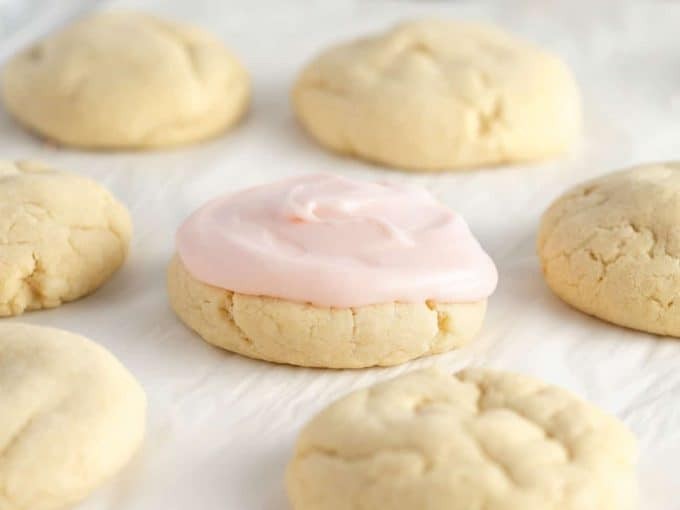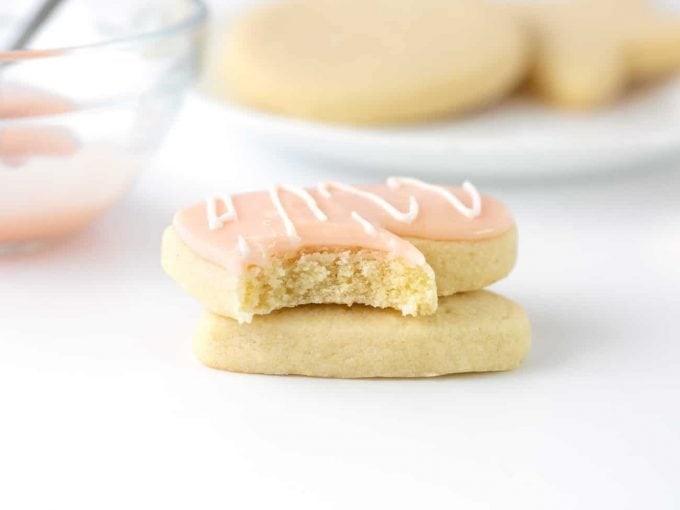Making pink frosting with food coloring can be a delightful experience, and at FOODS.EDU.VN, we’re here to show you how to achieve that perfect shade of pink every time. This guide provides you with the knowledge and skills to create stunning pink frosting for cakes, cookies, and more, ensuring a beautiful and delicious treat. Discover the secrets to mastering pink frosting, from choosing the right food coloring to achieving the ideal consistency.
1. Understanding the Basics of Pink Frosting
Creating the perfect pink frosting is more than just adding food coloring to a base; it’s about understanding the nuances of color mixing, the type of frosting you’re working with, and how each element interacts. This section will guide you through the foundational knowledge you need to embark on your pink frosting journey successfully.
1.1. What is Pink Frosting?
Pink frosting, at its core, is any frosting that has been tinted with a pink hue. This can range from the palest blush to a vibrant magenta, achieved by adding food coloring to a base frosting. The versatility of pink frosting makes it a favorite for various desserts, from elegant wedding cakes to whimsical birthday cupcakes. It evokes feelings of joy, celebration, and sweetness, making it a popular choice for bakers worldwide. The key is understanding how to control the color intensity and achieve the precise shade that complements your dessert.
1.2. Types of Frosting Suitable for Coloring
Different types of frosting react differently to food coloring. Some frostings are naturally whiter and provide a cleaner canvas for achieving true pinks, while others may have a slight yellow tint that can affect the final color. Here are some popular types of frosting and how well they take color:
| Type of Frosting | Color Acceptance | Notes |
|---|---|---|
| Buttercream | Excellent | Provides a smooth base; American buttercream can be slightly yellow, affecting the pink’s vibrancy. |
| Cream Cheese Frosting | Good | Has a slight tang and creamy color; best for pastel pinks as it may neutralize vibrant shades. |
| Royal Icing | Excellent | Dries hard, making it ideal for decorating cookies; accepts color evenly and can achieve a wide range of pinks. |
| Whipped Cream | Fair | Difficult to color intensely without deflating; best for very light pastel pinks. |
| Ganache | Good | Depending on the chocolate used, it can affect the pink’s hue; white chocolate ganache works best for true pinks. |




Understanding these nuances will help you choose the right frosting for your desired pink shade, ensuring a visually appealing and delicious result.
1.3. Types of Food Coloring
The type of food coloring you use significantly impacts the final color and consistency of your frosting. Here’s a breakdown of the most common types:
- Gel Food Coloring: Highly concentrated, gel food coloring provides intense color without adding excess liquid, making it ideal for frosting.
- Liquid Food Coloring: Commonly found in grocery stores, liquid food coloring is less concentrated and can alter the consistency of your frosting if used in large quantities.
- Powdered Food Coloring: This type of coloring is highly concentrated and doesn’t affect consistency, but it can be more challenging to blend smoothly.
- Natural Food Coloring: Derived from fruits, vegetables, and other natural sources, these colorings provide softer hues and may require more product to achieve the desired shade.
Choosing the right type of food coloring can make a significant difference in achieving your desired pink shade while maintaining the perfect frosting consistency.
1.4. Understanding Color Theory
A basic understanding of color theory can greatly enhance your ability to create the perfect pink frosting. Pink is essentially a tint of red, created by mixing red with white. The ratio of red to white will determine the intensity of the pink, with more red resulting in a deeper, more vibrant shade.
However, it’s also important to consider the undertones of your red food coloring. Some reds may have warm, orange undertones, while others have cooler, blue undertones. This can influence the final pink color, potentially leading to peachy or rosy hues. Experimenting with different brands and shades of red food coloring can help you achieve the specific pink you desire.
2. Step-by-Step Guide: Making Pink Frosting with Food Coloring
Achieving the perfect pink frosting requires precision and attention to detail. This step-by-step guide will walk you through the process, ensuring you create a beautiful and delicious frosting every time.
2.1. Gather Your Ingredients and Tools
Before you begin, make sure you have all the necessary ingredients and tools. This will streamline the process and prevent any last-minute scrambles. Here’s what you’ll need:
- Your choice of frosting base (buttercream, cream cheese, royal icing, etc.)
- Red food coloring (gel, liquid, or powder)
- White food coloring (optional, for lightening the pink)
- Mixing bowls
- Measuring spoons
- Spatulas or mixers
- Toothpicks (for precise color control)
- Paper towels (for easy cleanup)
2.2. Preparing the Frosting Base
Start with your chosen frosting base. If you’re making buttercream, ensure your butter is softened to room temperature for a smooth, lump-free consistency. For cream cheese frosting, use cold cream cheese to prevent it from becoming too runny.
If your frosting base has a yellow tint, you may want to add a touch of white food coloring to create a brighter canvas for your pink. This is especially helpful when using American buttercream, which tends to have a more pronounced yellow hue due to the high butter content.
2.3. Adding Food Coloring Gradually
The key to achieving the perfect pink is to add food coloring gradually. Start with a small amount of red food coloring, using a toothpick to transfer the color to your frosting. This allows for precise control and prevents you from accidentally adding too much color.
Dip the tip of a toothpick into the food coloring and then swirl it into your frosting. Mix well and assess the color. If you want a deeper pink, repeat the process, adding more color until you achieve your desired shade.
2.4. Mixing and Evaluating the Color
After each addition of food coloring, mix the frosting thoroughly to ensure the color is evenly distributed. Use a spatula or mixer to scrape the sides and bottom of the bowl, ensuring no streaks of white remain.
Once the color is fully incorporated, take a moment to evaluate the shade. Consider the lighting in your kitchen, as this can affect how the color appears. If the pink is too pale, add a bit more red food coloring. If it’s too dark, you can try adding a touch of white food coloring to lighten it.
2.5. Adjusting for Undertones
As mentioned earlier, the undertones of your red food coloring can influence the final pink color. If you notice that your pink is leaning too warm (peachy) or too cool (rosy), you can adjust the color by adding a tiny amount of another food coloring.
For example, if your pink is too peachy, add a minuscule amount of blue food coloring to neutralize the warmth. If it’s too rosy, add a tiny amount of yellow food coloring to warm it up. Remember to add these colors in very small increments, as even a tiny amount can make a noticeable difference.
2.6. Achieving the Perfect Consistency
In addition to color, consistency is crucial for perfect frosting. If your frosting is too thick, it will be difficult to spread or pipe. If it’s too thin, it will be runny and won’t hold its shape.
To adjust the consistency, add a small amount of liquid (milk, water, or cream) if the frosting is too thick. Add a small amount of powdered sugar if the frosting is too thin. Mix well after each addition and evaluate the consistency until it reaches your desired state.
3. Advanced Techniques for Pink Frosting
Once you’ve mastered the basics, you can explore advanced techniques to elevate your pink frosting game. These techniques will help you create unique and visually stunning frosting for your desserts.
3.1. Creating Ombré Frosting
Ombré frosting is a beautiful gradient effect that transitions from a light pink to a darker pink. This technique adds depth and visual interest to your cakes and cupcakes.
To create ombré frosting, divide your frosting into three or four bowls. Leave one bowl plain (white), and then add increasing amounts of red food coloring to the other bowls to create progressively darker shades of pink.
Layer the different shades of pink on your cake or cupcakes, starting with the lightest shade at the top and transitioning to the darkest shade at the bottom. Use a spatula or scraper to blend the edges of each layer, creating a seamless gradient effect.
3.2. Marbling Pink Frosting
Marbling is a technique that creates a swirling, marbled effect in your frosting. This is a fun and easy way to add visual interest to your desserts.
To marble pink frosting, start with a base of white frosting. Then, add dollops of pink frosting in various shades on top of the white frosting. Use a toothpick or skewer to swirl the colors together, creating a marbled effect. Be careful not to overmix, as this can muddy the colors.
3.3. Using Multiple Shades of Pink
Instead of just one shade of pink, try using multiple shades to create a more dynamic and visually appealing frosting. This can be achieved by piping different shades of pink side-by-side or by creating a mosaic effect with different pink hues.
Experiment with different combinations of pink shades to find what you like best. You can also add other colors, such as white, gold, or silver, to complement the pink and create a more sophisticated look.
3.4. Adding Flavor to Pink Frosting
While color is important, flavor is equally crucial. Enhance your pink frosting by adding complementary flavors that enhance the sweetness and create a more complex taste profile.
- Vanilla Extract: A classic addition that enhances the overall sweetness and aroma of the frosting.
- Almond Extract: Adds a subtle, nutty flavor that pairs well with pink frosting, especially when used on almond-flavored cakes or cookies.
- Strawberry Extract: Enhances the pink color and adds a fruity flavor that complements desserts like strawberry cupcakes or cakes.
- Rose Water: Provides a delicate floral note that adds an elegant touch to pink frosting, perfect for special occasions.
- Lemon Zest: Adds a bright, citrusy zing that balances the sweetness of the frosting, making it a refreshing choice for summer desserts.
Experiment with these flavorings to create unique and delicious pink frosting that perfectly complements your desserts.
4. Troubleshooting Common Issues
Even with the best intentions, things can sometimes go wrong when making pink frosting. Here are some common issues and how to troubleshoot them:
4.1. Frosting is Too Dark
If your frosting is too dark, don’t panic. You can lighten it by adding a small amount of white food coloring. Mix well and evaluate the color. Repeat until you achieve your desired shade. Alternatively, you can add more of the original, uncolored frosting to dilute the color.
4.2. Frosting is Too Light
If your frosting is too light, simply add more red food coloring, a little at a time, until you achieve your desired shade. Remember to mix well after each addition and evaluate the color.
4.3. Frosting is Too Runny
If your frosting is too runny, add a small amount of powdered sugar to thicken it. Mix well and evaluate the consistency. Repeat until it reaches your desired state. Be careful not to add too much powdered sugar, as this can make the frosting too sweet.
4.4. Frosting is Too Thick
If your frosting is too thick, add a small amount of liquid (milk, water, or cream) to thin it. Mix well and evaluate the consistency. Repeat until it reaches your desired state. Be careful not to add too much liquid, as this can make the frosting too runny.
4.5. Frosting Has Streaks of Color
If your frosting has streaks of color, it means the food coloring hasn’t been fully incorporated. Continue mixing until the color is evenly distributed. Use a spatula to scrape the sides and bottom of the bowl, ensuring no streaks of white remain.
5. Pink Frosting Recipes
To help you get started, here are a few of our favorite pink frosting recipes:
5.1. Classic Pink Buttercream Frosting
Ingredients:
- 1 cup (2 sticks) unsalted butter, softened
- 3-4 cups powdered sugar
- 1/4 cup milk or cream
- 1 teaspoon vanilla extract
- Red food coloring
Instructions:
- In a large mixing bowl, beat the softened butter until smooth and creamy.
- Gradually add the powdered sugar, one cup at a time, beating well after each addition.
- Add the milk or cream and vanilla extract, and beat until light and fluffy.
- Add red food coloring, a little at a time, until you achieve your desired shade of pink.
- Mix well and adjust the consistency as needed.
5.2. Pink Cream Cheese Frosting
Ingredients:
- 8 ounces cream cheese, softened
- 1/2 cup (1 stick) unsalted butter, softened
- 3-4 cups powdered sugar
- 1 teaspoon vanilla extract
- Red food coloring
Instructions:
- In a large mixing bowl, beat the softened cream cheese and butter until smooth and creamy.
- Gradually add the powdered sugar, one cup at a time, beating well after each addition.
- Add the vanilla extract and beat until light and fluffy.
- Add red food coloring, a little at a time, until you achieve your desired shade of pink.
- Mix well and adjust the consistency as needed.
5.3. Vegan Pink Frosting
Ingredients:
- 1 cup vegan butter, softened
- 3-4 cups powdered sugar
- 1/4 cup plant-based milk
- 1 teaspoon vanilla extract
- Red food coloring (vegan)
Instructions:
- In a large mixing bowl, beat the softened vegan butter until smooth and creamy.
- Gradually add the powdered sugar, one cup at a time, beating well after each addition.
- Add the plant-based milk and vanilla extract, and beat until light and fluffy.
- Add red food coloring, a little at a time, until you achieve your desired shade of pink.
- Mix well and adjust the consistency as needed.
6. Serving Suggestions and Creative Ideas
Pink frosting is incredibly versatile and can be used in various creative ways to enhance your desserts. Here are some serving suggestions and creative ideas to inspire you:
6.1. Cakes and Cupcakes
The most common use for pink frosting is on cakes and cupcakes. Whether it’s a classic vanilla cake, a rich chocolate cake, or a batch of fluffy cupcakes, pink frosting adds a touch of elegance and sweetness.
- Birthday Cakes: Use bright pink frosting to create a fun and festive birthday cake. Add sprinkles, candies, and other decorations to make it extra special.
- Wedding Cakes: Opt for a soft, pastel pink frosting for a romantic and elegant wedding cake. Add edible flowers or pearls for a touch of sophistication.
- Baby Shower Cupcakes: Use light pink frosting to create adorable baby shower cupcakes. Add baby-themed decorations, such as rattles, pacifiers, and baby carriages.
6.2. Cookies
Pink frosting can also be used to decorate cookies, adding a pop of color and sweetness.
- Sugar Cookies: Use pink royal icing to decorate sugar cookies for holidays, birthdays, or special occasions. Get creative with different designs and patterns.
- Shortbread Cookies: Spread a thin layer of pink buttercream frosting on shortbread cookies for a simple yet elegant treat.
- Gingerbread Cookies: Use pink frosting to decorate gingerbread cookies for Christmas or other winter holidays.
6.3. Other Desserts
Pink frosting can be used to enhance a variety of other desserts, adding a touch of sweetness and visual appeal.
- Brownies: Spread a layer of pink frosting on top of brownies for a decadent and colorful treat.
- Pies: Use pink frosting to decorate the edges of pies, adding a touch of elegance and sweetness.
- Fruit Pizza: Create a fruit pizza with a sugar cookie crust and a layer of pink frosting. Top with fresh fruit for a healthy and delicious dessert.
6.4. Creative Decoration Ideas
- Sprinkles: Add sprinkles to your pink frosting for a fun and festive look. Use different colors, shapes, and sizes of sprinkles to create unique designs.
- Edible Flowers: Add edible flowers to your pink frosting for a romantic and elegant touch. Use fresh or dried flowers, such as roses, pansies, or violets.
- Candies: Add candies to your pink frosting for a sweet and playful look. Use different types of candies, such as M&Ms, gummy bears, or chocolate chips.
- Glitter: Add edible glitter to your pink frosting for a sparkly and glamorous touch.
7. The Science Behind Food Coloring
Food coloring isn’t just about aesthetics; it involves fascinating chemical processes. Understanding the science behind it can help you use it more effectively and safely.
7.1. Types of Food Coloring Compounds
Food colorings are broadly categorized into two types:
- Dyes: These are water-soluble compounds that color food through absorption. They often provide more intense colors but can sometimes bleed or fade over time.
- Lakes: These are dyes that have been rendered insoluble by combining them with metallic salts. Lakes are more stable and less prone to bleeding, making them ideal for products with low moisture content, like frostings.
7.2. How Color Interacts with Different Ingredients
The color of your frosting can be affected by the ingredients you use. For example, acidic ingredients like lemon juice or vinegar can alter the hue of certain food colorings. Similarly, fat content can influence how evenly the color is dispersed.
7.3. Safety and Regulations
Food colorings are heavily regulated to ensure they are safe for consumption. In the United States, the Food and Drug Administration (FDA) oversees the approval and use of food colorings. Always use food colorings from reputable brands and follow the recommended usage guidelines.
7.4. Natural vs. Artificial Food Coloring
- Natural Food Colorings: Derived from natural sources such as fruits, vegetables, and spices, these colorings are often perceived as healthier. However, they can be less stable and may not provide as vibrant colors as artificial options. Examples include beet juice for red, turmeric for yellow, and spirulina for blue.
- Artificial Food Colorings: These are synthetically produced and offer a wider range of more intense and stable colors. They are generally less expensive than natural colorings but have been the subject of some health concerns.
8. Pink Frosting Around the World
Pink frosting isn’t just a modern trend; it has historical and cultural significance in many parts of the world.
8.1. Historical Significance
The use of colored frostings dates back centuries, with early examples found in European confectionery. Pink, often associated with sweetness and celebration, became increasingly popular in the 20th century with the rise of commercial baking and the availability of food colorings.
8.2. Cultural Variations
In some cultures, pink frosting is a staple for specific celebrations. For example, in certain Latin American countries, pink frosting is commonly used for quinceañera cakes, symbolizing the transition from girlhood to womanhood. In Japan, pink-colored sweets are often associated with cherry blossom season and the celebration of new beginnings.
8.3. Modern Trends
Today, pink frosting is experiencing a resurgence in popularity, driven by social media and the trend towards visually stunning desserts. From pastel pinks to vibrant fuchsias, bakers are using pink frosting in innovative ways to create eye-catching and delicious treats.
9. Tips for Storing Pink Frosting
Proper storage is essential to maintain the color, consistency, and flavor of your pink frosting. Here are some tips to keep it fresh:
- Airtight Container: Store leftover frosting in an airtight container to prevent it from drying out or absorbing odors from the refrigerator.
- Refrigeration: Most frostings, especially those containing dairy products like buttercream or cream cheese frosting, should be refrigerated. They can typically be stored in the refrigerator for up to a week.
- Freezing: For longer storage, you can freeze pink frosting. Place it in an airtight, freezer-safe container and freeze for up to three months. Thaw it in the refrigerator overnight before using.
- Room Temperature: Some frostings, like royal icing, can be stored at room temperature in an airtight container. However, it’s best to check the specific storage instructions for your recipe.
10. FAQs About Making Pink Frosting
Here are some frequently asked questions about making pink frosting:
- What’s the best type of food coloring to use for pink frosting? Gel food coloring is generally the best choice, as it provides intense color without adding excess liquid.
- How do I prevent my pink frosting from being too dark? Add food coloring gradually, using a toothpick for precise control.
- Can I use natural food coloring for pink frosting? Yes, but keep in mind that natural food colorings may not provide as vibrant colors as artificial options.
- How do I fix frosting that is too runny? Add a small amount of powdered sugar to thicken it.
- How do I fix frosting that is too thick? Add a small amount of liquid (milk, water, or cream) to thin it.
- Can I make pink frosting without food coloring? Yes, you can use natural ingredients like beet juice or raspberry puree to color your frosting pink, but the color may be less intense.
- How long does pink frosting last? Most frostings can be stored in the refrigerator for up to a week or frozen for up to three months.
- Can I use pink frosting on any type of dessert? Yes, pink frosting is versatile and can be used on cakes, cupcakes, cookies, and other desserts.
- How do I create an ombré effect with pink frosting? Divide your frosting into different bowls, add increasing amounts of red food coloring to each bowl, and then layer the different shades on your cake or cupcakes.
- What are some flavorings that pair well with pink frosting? Vanilla extract, almond extract, strawberry extract, rose water, and lemon zest are all great options.
At FOODS.EDU.VN, we are passionate about providing you with the knowledge and skills to create delicious and visually stunning desserts. Making pink frosting with food coloring is just one of the many culinary adventures you can embark on. With the right techniques and a little creativity, you can create beautiful pink frosting that will impress your friends and family.
Remember, the journey of mastering pink frosting doesn’t end here. FOODS.EDU.VN is your go-to resource for all things culinary, offering a wealth of knowledge and inspiration to help you elevate your baking skills.
Are you ready to take your baking to the next level? Visit FOODS.EDU.VN at 1946 Campus Dr, Hyde Park, NY 12538, United States, or contact us via Whatsapp at +1 845-452-9600 to discover a world of culinary delights. From detailed recipes to expert tips and techniques, we have everything you need to become a confident and creative baker.
Explore our extensive collection of articles, tutorials, and recipes to unlock new possibilities in the kitchen. Whether you’re a beginner or an experienced baker, foods.edu.vn is here to guide you every step of the way. Don’t miss out on the opportunity to expand your culinary horizons and create unforgettable desserts that will delight your senses. Join our community of food enthusiasts today and let your baking journey begin!